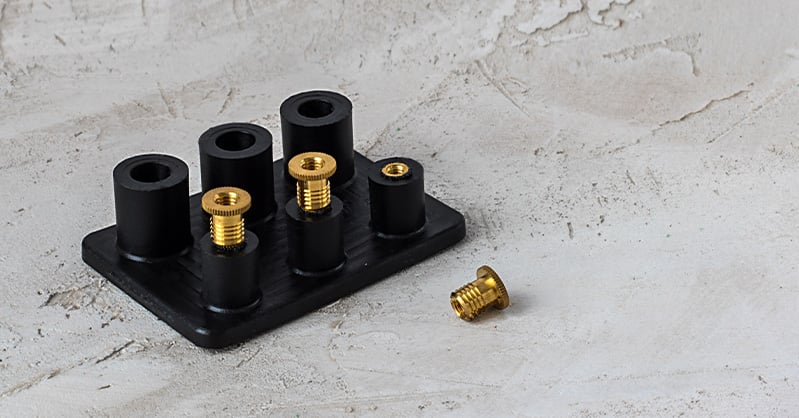Metal Threaded Inserts Best Choice for Plastic Applications
Selecting the best threaded insert for plastic applications can be challenging, particularly when it comes to plastic assemblies that require multiple instances of assembly and breakdown. For plastic assemblies like this, metal threaded inserts are the best and most reliable choice for strength, resilience and torque capacity.
Let’s take a look at how metal threaded plastics inserts work with plastic assemblies, the different insertion methods and some other factors to consider when deciding on the best threaded insert for your product.
Factors to Consider for Plastic Inserts
There are a number of important factors to consider when evaluating your choice of insert type and insertion method.
Overall Strength
Torque is critical to selecting the proper threaded insert for your plastic assembly. Pull-out force and resistance to insert twisting are very important considerations in matching the type and nature of the plastic product you’re using. Longer threaded inserts have greater pull-out capacity while an insert with a wider diameter will have greater overall torque capacity.
Knurling Pattern
The knurling pattern determines a threaded insert’s capacity for pull-out and torque resistance. Knurling is created during the metal work process where a pattern is cut or rolled onto the outside of a workpiece.
The greatest torque resistance is offered by straight knurls; this is a trade off, however, as this results in less pull-out capacity. Grooves placed between bands can help increase pull-out resistance. Diagonal knurl patterns offer a more balanced approach, as this pattern offers resistance in both directions. The most common knurl pattern is diamond-shaped, which creates resistance in all directions.
Material Considerations
There are two primary plastic materials to which threaded inserts are applied.
Thermoplastics can be melted and recast over and over again. When heated, thermoplastics become like liquid and then when cooled they solidify. This process can be repeated nearly endlessly. Polypropylene, polyethylene, polyvinyl chloride, polystyrene, polyethylene terephthalate, and polycarbonate are the most common types of thermoplastics. Thermoplastic insertion approaches include heat staking and ultrasonic methods.
Thermoset plastics are molded via a permanent chemical reaction caused by the application of heat, pressure and time. Once set, thermoset plastic materials cannot be altered. Insertion applications include molding-in and cold insertion.
Stainless steel and aluminum threaded inserts are becoming more and more popular due to sustainability regulations and both are more effective than brass with greater strength and less weight, respectively.
Insertion Methods
Heat-Staking Threaded Inserts (Thermoplastics Only)
This approach is for Thermoplastic use only, offer high performance along with lower overall costs. This process involves the insert getting heated with a thermal press until the insert melts a small part of the hole’s edges while it is being pushed into the thermoplastic assembly. Melted resin then seeps and fills the knurl pattern to form a firm bond once hardened. This is the most typical thermoplastic insertion process because its less costly and is amenable to automation processes, allowing multiple insertions at a time.
Ultrasonic Assisted Threaded Inserts (Thermoplastics Only)
Ultrasonics are also deployed to melt the periphery of the hole. While heat-staking uses heat to melt the hole edge, the ultrasonic method uses a vibration frequency to achieve melting. Unlike heat-staking that is easy to control, ultrasonic insertion has greater control requirements, as the application of the vibrations needs to be very precise to avoid material damage. The ultrasonic process is less easily automated and is less frequently utilized.
Molded-In Threaded Inserts (Thermosets and Thermoplastic Application)
This method ensures the very best pull-out and torque performance. This process involves machine-directed insertions into the mold; resin is then added to completely encase the insert, which creates a super strong bond.
However, a more complicated core with close tolerances between the pins and inserts is required for the molded-in approach. The process also tends to take more time than heat-staking and ultrasonic processes.
Cold Pressed-In Threaded Inserts (Thermosets)
This is the easiest and least costly plastic insertion method that requires a basic press for execution. Essentially, inserts are simply pressed into the thermoset plastic mold; this approach results in a weaker bond and overall strength, but generally is a sturdy alternative that will work and save on costs. Although they may not perform as well as the aforementioned types, cold pressed-in inserts are a highly economical alternative because they are easy to install and typically do not require special auxiliary equipment.
We hope this quick overview on threaded inserts for plastics will be useful as you search for the best and most efficient threaded inserts to maximize product performance.
HTF has a track record of more than 30 years of delivering the components our clients need when they need them. We have been a trusted distributor partner to countless companies and we are always poised to help you in any way we can. We have a wide array of threaded inserts for plastics available that can meet any need and function, and we can deliver it faster than our competition. We take great pride in having what you need and getting it to you when you need it, while delivering the highest level of customer service in the industry. That’s why the top manufacturers in the industry partner with us.
Reach out to us today. We’re ready to help.









